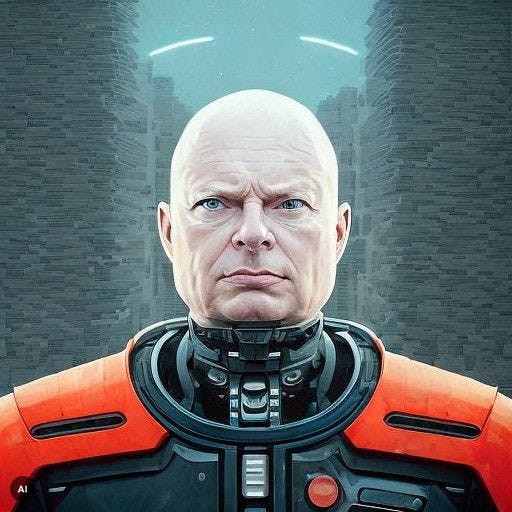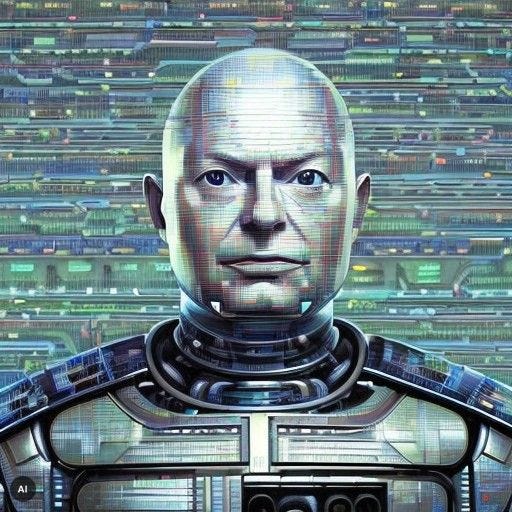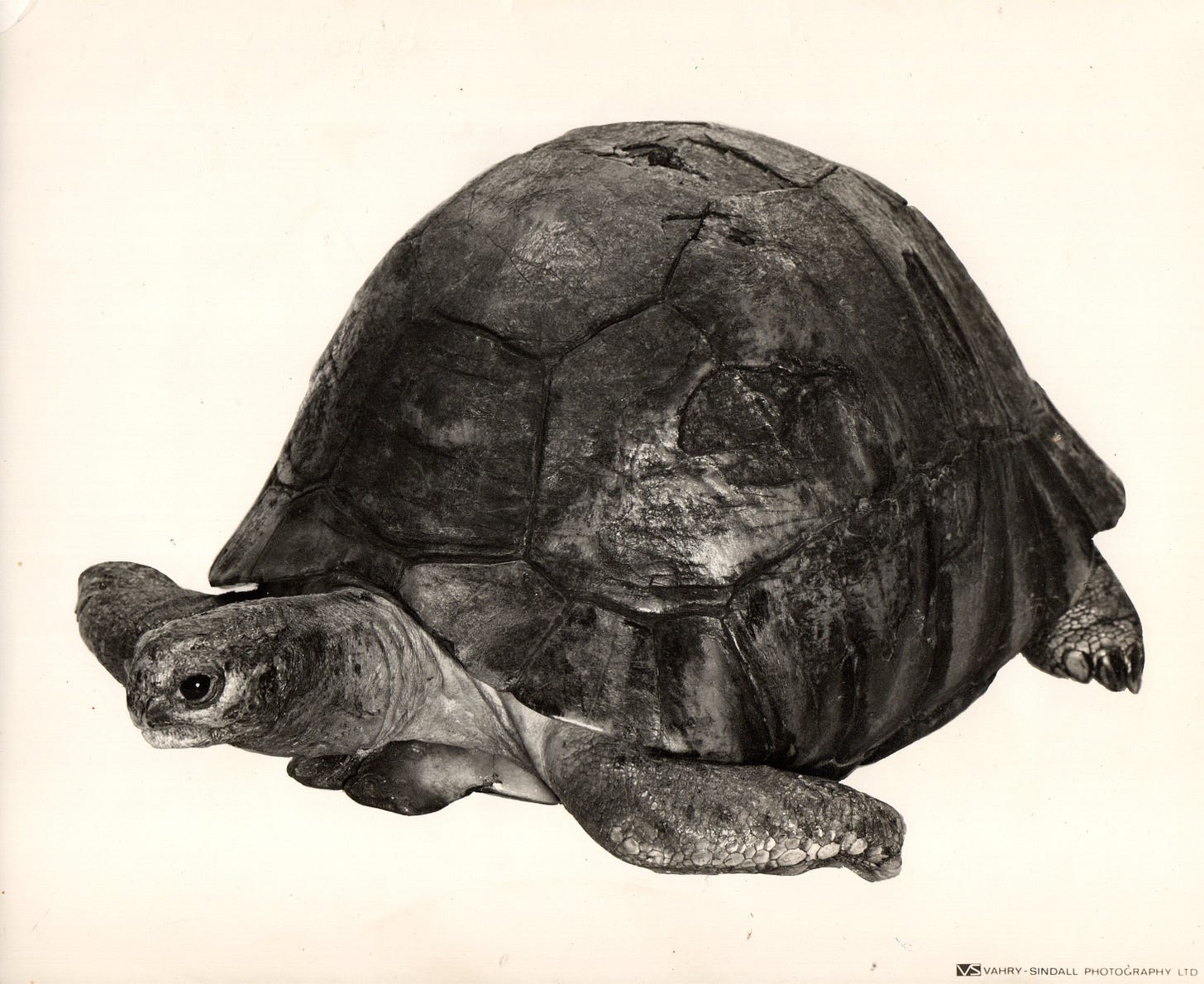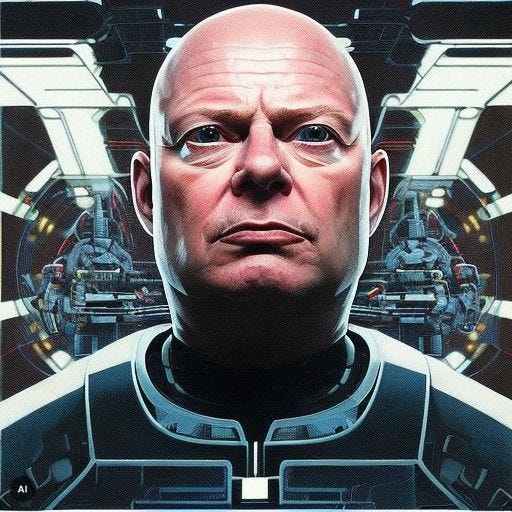When it comes to reading Science Fiction, I was doomed. It had a big impact on my future career, at times on the leading and bleeding edge of technology. My father had a large collection of SciFi books, not as big as mine today, but back then it was a lot. I started reading them at a very early age and by the time I was about 14, I was full-on reading about possible futures.
I started thinking about what it would be like to be an Enhanced Human. Of course that was around the time the Steve Austin crashed and had to be rebuilt.
In the 70s a lot of the writers of the genre were scientists, and they weren’t just writing from their imagination, but from what they knew, even if it was on a tangent.
Maybe it could have been Luigi instead of Steve Austin. Ironically, I got this image from a genealogy program.
In one of life’s subtle ironies, in 2012, I wrote a short blog, influenced by bionics, imagining an Enhanced World Games. I have made a lot of predictions as a futurist over the years, and it looks like this one might come true, as they are proposing a set of games where enhancements are not only, legal, but encouraged. It’s easy for people to be smart after the fact, but at least I can show in some of my blogs, that I predicted it.
Isaac Asimov, one of my father’s favorites, was a biochemist and a professor at Boston University. He wrote the famous 5 Laws of Robotics, in a short story in 1942 called Runaround.
A robot may not injure a human being or, through inaction, allow a human being to come to harm.
A robot must obey the orders given it by human beings except where such orders would conflict with the First Law.
A robot must protect its own existence as long as such protection does not conflict with the First or Second Law.
A robot must not harm humanity, or, by inaction, allow humanity to come to harm.
A robot must strive to fulfill its function in accordance with the first four laws.
In 1985 he introduced the Zeroth Law, in his novel, Robots and Empire, which has to be very appropriate today.
A robot may not harm humanity, or, by inaction, allow humanity to come to harm.
We naively thought that when we got to the point where robots could be created, those laws would be fundamental, but we already have Drones aka UAVs or Unmanned Aerial Vehicles, which have been demonstrated as being successful in a number of theatres including Ukraine.
We have UGVs or Unmanned Ground Vehicles, aka Robotic Combat Vehicles currently under development. Then there are companies like Ghost Robotics. You might have seen one of their robots on the news, that looks and moves with greater ease than a human. It is said they perform best when not being controlled by us. Check this out. It is not CGI, but a military test of this technology.
I guess it is less distasteful than a robot that looks like a human, or perhaps a human brain inside a cyborg body, basically a brain carried inside a machine.
Another favorite writer of that time was Isaac Asimov. I was at school when the movie 2001 A Space Odyssey came out. I don’t know how we did it, but at school, we got a projector and watched it. Who doesn’t remember “Open the pod bay doors, Hal”?
Philip K Dick, in his story, Do Androids Dream of Electric Sheep, which inspired the movie Blade Runner, the protagonist, Rick Deckard was hired to ‘retire’ 6 androids and discovered that they were sentient, subsequently developing a relationship with one.
In a spooky coincidence, as the late Dame Edna Everage would have said, the forward in this book said:
“Auckland
A turtle which explorer Captain Cook gave to the King of Tonga in 1777 is still alive today, in the Auckland Museum. I have seen it. It is a large, placid creature, and it seems to have lost none of its vitality over the years.
I thought of this turtle when I was writing Do Androids Dream of Electric Sheep?, a novel about a future world in which animals are so rare that they are used as status symbols. In this world, a live animal is worth more than a fortune.
The turtle in Auckland is a reminder that even in the most difficult of times, life can still find a way to survive. It is also a reminder that we should never take the natural world for granted.
I hope that Do Androids Dream of Electric Sheep? will make readers think about the importance of animals and the natural world. I also hope that it will make readers think about the nature of humanity and what it means to be human.”
This turtle was called Tu’i Malila, and when it died in 1965 at the age of 188, my father, who worked at Auckland Museum was asked to preserve it for history. This is what it looked like after he had completed the job.
An article about this appeared in the New Zealand Herald:
Leo Cappel, Taxidermist to the Stars, Preserved Tu'i Malila, the World's Oldest Living Tortoise
Leo Cappel was a taxidermist who worked in Auckland, New Zealand. He was known for his work on animals of all sizes, from insects to elephants. In 1965, Cappel was asked to taxidermy Tu'i Malila, the world's oldest living tortoise. Tu'i Malila had died at the age of 188, and the royal family of Tonga wanted her preserved so that she could be displayed in the Auckland Museum.
Cappel took great care in preserving Tu'i Malila. He used a special technique that allowed him to keep her skin and bones intact. He also made sure that her expression was peaceful and serene. The result was a beautiful and lifelike taxidermy that has been on display in the Auckland Museum ever since.
Cappel's work on Tu'i Malila was so well-done that it earned him the nickname "Taxidermist to the Stars." He went on to taxidermy many other famous animals, including the elephant that starred in the film "Dumbo" and the gorilla that starred in the film "King Kong."
Cappel's work was not only beautiful, but it was also educational. He used his taxidermy to teach people about animals and their importance to the natural world. He also used his taxidermy to raise awareness of endangered species.
Cappel's work has had a lasting impact on the world of taxidermy. He is considered to be one of the greatest taxidermists of all time, and his work continues to inspire taxidermists around the world.
I realize I haven’t included any songs. I’ll leave you with this one by Frank Zappa from Joe’s Garage, called Sy Borg.
I’ll leave the last word to Frank, who I’m sure, quite rightly foresaw android sex appliances, being part of the future. That’s altogether a different story, which could also have military uses. Think about it…. (You may laugh, but check this out.) :
“Fish and chips isn't what it used to be. Now companies are phishing for you in order to chip you. Consider the Consequences and Be Aware. Joe didn't, and now he spends his time in the Utility Muffin Research Kitchen with Lady Gaga arrogantly twisting his icing anointment utensil in a Flambeed state of mass cornfusion.”
I need to go and plug myself in now. See you next time. Leave a comment or share with someone you think might be interested.






